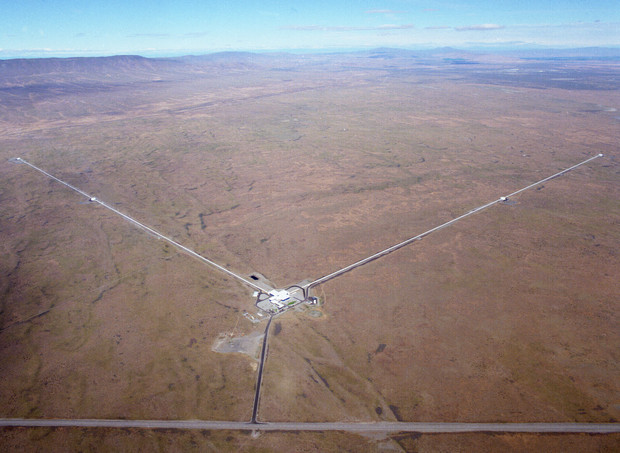The scientists behind the Advanced Laser Interferometer Gravitational-Wave Observatory are getting ready to reveal their latest findings, amid a flurry of speculation over whether or not they’ve made the first-ever detection of waves rippling through spacetime.
Fred Raab, the head of the LIGO laboratory in Hanford, Wash., isn’t telling.
“As we have done for the past 15 years, we take data, analyze the data, write up the results for publication in scientific journals, and once the results are accepted for publication, we announce results broadly on the day of publication or shortly thereafter,” he told GeekWire in an email.
In a follow-up phone call, Raab noted that if the historical trend holds true, the results should be ready to submit for publication as early as this month.

LIGO Hanford
The beamlines for the LIGO detector site at Hanford stretch out across the desert terrain of southeastern Washington. Each arm of the L-shaped detector is 2.5 miles long. (Credit: LIGO)
LIGO looks for gravitational waves by monitoring ever-so-slight perturbations in laser beams as they bounce around through 2.5-mile-long tunnels. Two observatories have been built, in Hanford and near Livingston, La., so that the results from one facility can double-checked against results from the other.
For weeks, physicists have been passing along rumors that the long-running experiment has finally registered gravitational waves after 15 years of looking.
That would be momentous, in part because it would confirm an as-yet-unproven prediction made by Albert Einstein in his general theory of relativity. It would also open up a new window on extreme cosmic phenomena, including clashing neutron stars and merging black holes.
The hubbub hit a crescendo when Lawrence Krauss, a theoretical physicist at Arizona State University, said in a series of tweets that gravitational waves may have been detected during Advanced LIGO’s latest experimental run:
My earlier rumor about LIGO has been confirmed by independent sources. Stay tuned! Gravitational waves may have been discovered!! Exciting.
Krauss faced criticism from some scientists who said the rumors were premature – particularly because fake signals are occasionally inserted into the LIGO data to test the equipment as well as the analytical progress. In one case, the fakery was not revealed until the scientists were just about to submit their results for publication.
There’s also a cautionary tale in the case of BICEP2, a different experiment conducted in Antarctica. In 2014, the BICEP2 collaboration reported finding the first evidence of primordial gravitational waves, which was seen as the best confirmation yet for inflationary Big Bang theory. Over the months that followed, other findings led the researchers to acknowledge that the effect was caused by galactic dust rather than gravitational waves.
Despite the caveats, physicists are continuing to trade rumors. This week, Czech physicist Luboš Motl addressed the topic with an ironically unscientific survey on his blog, “The Reference Frame.” So far, more than half of the survey’s respondents support the view that the LIGO team would announce the discovery of gravitational waves on Feb. 11.
Raab declined to discuss the rumors. But with each experimental run, LIGO is bettering its chances of making a detection.
For the campaign that concluded last month, the detectors were sensitive enough to pick up the emanations from the merger of two neutron stars to form a black hole as far away as 260 million light-years (40 to 80 megaparsecs). The detectors are now being upgraded and recommissioned, with sensitivity increased to a range of as much as 390 million light-years (100 to 120 megaparsecs).
“We expect to be in that commissioning phase at least until sometime this summer,” Raab said. Then the next six-month observing run will get under way.
If LIGO reports a detection, either next month or next year, that will be a cause for celebration. But if gravitational waves aren’t detected, relativity theory may have to go back to the drawing board.
